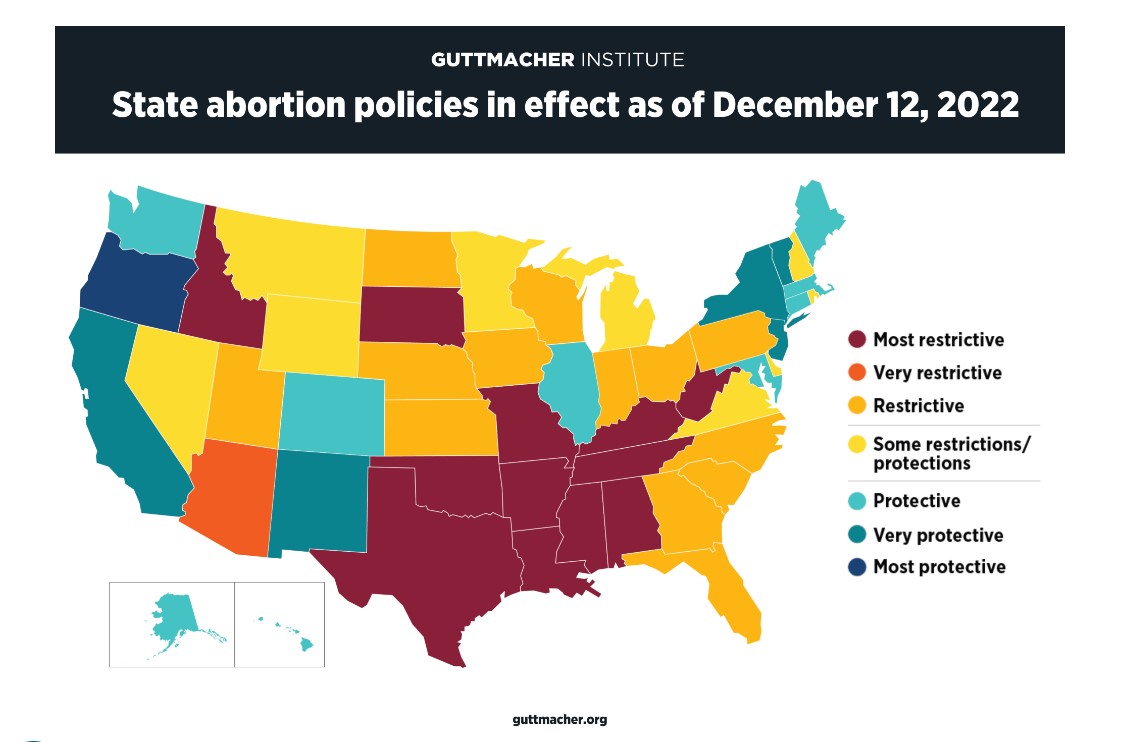We Cannot Have Women’s Rights Without Abortion Rights
April 3, 2023
by Amalia Egri Freedman, Chief Executive Officer
When SCOTUS ruled on Dobbs v. Jackson Women’s Health Organization in June 2022, many millions of women, other people with uteruses, and the people who love them, were faced with the devastating reality that their rights to bodily autonomy were being gutted nearly 50 years after having been enshrined in Roe v. Wade in 1973.
The overturning of Roe v. Wade was the culmination of decades of efforts by organizations and politicians working to restrict reproductive rights, including but not limited to the right to abortion. In this, the United States is in contrast to the rest of the world – in the last two decades, more than 40 counties have changed their laws related to abortion, and all but two – now three, with the United States included – have done so by liberalizing their laws and expanding the conditions under which abortion is legal.
And yet the reality in the United States is that now, nearly one in three women live in states in which abortion is either banned outright or severely restricted, as laws made obsolete by Roe come back into force and new bans are enacted. Keeping track of the constantly shifting laws and court cases challenging them is dizzying from a policy perspective and has wreaked havoc on the care landscape for patients and providers trying to access and provide care. In several states, legislatures have passed laws that are being blocked by courts, and providers must attempt to provide care without knowing whether the procedure they’re scheduling for the week following will still be legal. This is even more emotionally and financially destructive for patients, who face ever-increasing wait times and uncertainty about the availability of care.
Even before Roe was overturned, dozens of different types of abortion restrictions were in place across the country, leading to unnecessary barriers to care and making abortion functionally unavailable for millions of women. Mandatory waiting periods, unnecessary ultrasounds, structural facility requirements, provider admitting privileges, and more are often proposed under the guise of patient safety but are paternalistic and designed to add to the cost and burden on women to access care. The effect of these requirements is the intended one – dozens of facilities have been forced to close over the last several decades, removing access to safe care for millions of women. And in some of the most drastic cases, restrictions that only have exceptions for danger to the life of the mother force providers to allow their patients to reach a medical crisis before they are legally allowed to intervene with what could easily have been preventative care.
All of these restrictions disproportionately impact people who already have the greatest barriers to care: people with low incomes, young people, LGBTQ+ people, and people of color. The additional financial and logistical burdens to obtain abortion care will continue to make it increasingly difficult to access for women who do not have the means to take time off of work, obtain childcare, and pull together funds to travel out of state for a procedure that could easily be provided at a local clinic. There is ample evidence of the harms of denying care to women who seek abortions: the resulting economic hardship and insecurity last for years; the financial well-being and development of a woman’s child or other children is negatively impacted, and women are more likely to stay in touch with a violent partner, among other impacts.
There are bright spots to celebrate in the midst of the backsliding of rights, however. Several states have enshrined the right to abortion in their constitutions and have enacted laws to protect both clients and providers from punitive measures. Voters in some deeply red states, notably Kansas and Kentucky, have resoundingly rejected efforts to exclude abortion rights from the constitution, illustrating the well-documented fact that Americans of all races, incomes, genders, and political parties overwhelmingly believe that abortion should be legal in at least some circumstances, despite the overall partisan divide between pro-choice and anti-choice. The FDA has recently finalized a rule change that broadens the availability of abortion pills to more pharmacies, and over the last several years, medication abortion, including as provided through telehealth appointments, has become an increasingly important means of access to abortion for millions of women.
California is among the states that has strengthened protections for abortion and for reproductive health and rights more broadly, enacting a series of laws in 2022. These laws together are intended to improve access, protect patients and clinicians, increase infrastructure for abortion provision, and support funding for procedures and travel costs. These laws will also help California, proclaimed by Governor Newsom as an “abortion sanctuary state”, support the influx of people coming from other states to access care.
As we celebrate Women’s History Month, it is important to remember that the fight for equal rights is not a historical chapter. Now as much as ever, women’s rights – including, but not limited to – the right to control our own bodies is under attack, and we must continue to fight for a nation and world in which people of all genders have equal rights.

Honoring Indigenous Justice on Indigenous Peoples’ Day 2025
RDA Consulting observes Indigenous Peoples’ Day annually in place of the Columbus Day Federal holiday. First observed in Berkeley, California in 1992, the celebration of Indigenous Peoples’ Day has spread across the United States. Today, 17 states, the District of Columbia, Puerto Rico, and numerous localities nationwide celebrate Indigenous Peoples’ Day on the second Monday…

Supporting Juneteenth and Abundant Opportunities
We know that poverty disproportionately affects Black women and children in the US, which compounds disparities in maternal and child health. These disparities, an effect of systemic racism, are further exacerbated by social and economic stressors. The results of poverty, including lack of safe housing and access to healthy food, and the stress created by…
